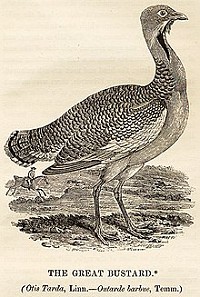The Great Bustard

Great bustard

Eighteenth century drawing
This piece was inspired by the display case in Louth Museum of a male and female Great Bustard, once a native bird of Lincolnshire.
In 1797, the naturalist and wood carver Thomas Bewick expressed his surprise that the British had not domesticated the Great Bustard, and reared it as a bird to rival the Turkey. The idea of sitting down to a traditional Great Bustard Dinner on Christmas Day may seem a strange one, but Bewick's fears that otherwise the bird could become extinct in this country proved to be correct, when the last native bird was shot in 1832. It was last seen in Louth in 1818, though migrant birds were occasionally spotted in the county throughout the 19th Century, the last ones appearing in December 1902, in Tetney and Grimsby. Both were shot.
There are, though, around 45,000 of these birds scattered around the world, from Portugal to Mongolia, with many (around 60% of them) in Spain. The Great Bustard Group founded a project to reintroduce them into Britain, starting in 2004, with fledgling birds brought from Russia, and settled on Salisbury Plain. Since then, the emphasis has switched to importing eggs from Spain, and hatching them here. The project has had some success, with around 100 birds now resident.
Although a long-term aim of this group is to extend the number of breeding sites in the UK, so far nowhere other than Salisbury Plain has been tested, and I'm unaware of any plan to reintroduce them to Lincolnshire.
The Great Bustard is amongst the heaviest of birds capable of flight, and adult males can weigh as much as 46 lb or 20 kg. Although, when disturbed, their natural inclination is to run, rather than fly (they can achieve a fast running speed, as much as 30 mph), they are also capable of lengthy airborne migration (as far as 2,000 km). Their preferred habitat is rolling grassland, or, as in Eastern Europe, the steppe.
They have a mixed diet, consisting of plants, seeds, and insects. As a ground-nesting bird, they are vulnerable to predation from many creatures, particularly foxes and crows, who target the eggs and the young birds. Because of its size and speed, and tendency to gather in groups, the adult bird is relatively safe from predators, though may occasionally be taken by wolves or lynx, where these are native species.
The Great Bustard forms part of the Coat of Arms for the counties of Wiltshire and Cambridgeshire, and is remembered in Lincolnshire in the name of the Bustard Inn in South Raceby, near Sleaford.